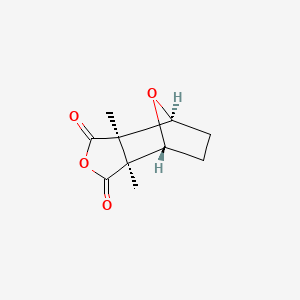D0835 | cantharidin
| Toxicity | Dose | Time | Species | Model | Method | Action | Positive criterion | Reference |
|---|---|---|---|---|---|---|---|---|
| MEMBRANE POTENTIAL | 0.15±0.08 | human | qHTS-HepG2 | MMP assay | decrease | IC50 | 163 | |
| MEMBRANE POTENTIAL | 0.12 | human | HepG2 | MMP assay | decrease | IC50 | 163 | |
| MEMBRANE POTENTIAL | 0.45±0.30 | rat | hepatocytes | MMP assay | decrease | IC50 | 163 | |
| Pictogram | Signal | Statements | Precautionary Statement Codes |
|---|---|---|---|
  |
Danger |
Aggregated GHS information provided by 46 companies from 7 notifications to the ECHA C&L Inventory. Each notification may be associated with multiple companies. H300 (100%): Fatal if swallowed [Danger Acute toxicity, oral] H315 (95.65%): Causes skin irritation [Warning Skin corrosion/irritation] H319 (95.65%): Causes serious eye irritation [Warning Serious eye damage/eye irritation] H335 (93.48%): May cause respiratory irritation [Warning Specific target organ toxicity, single exposure Respiratory tract irritation] Information may vary between notifications depending on impurities, additives, and other factors. The percentage value in parenthesis indicates the notified classification ratio from companies that provide hazard codes. Only hazard codes with percentage values above 10% are shown. |
P261, P264, P270, P271, P280, P301+P310, P302+P352, P304+P340, P305+P351+P338, P312, P321, P330, P332+P313, P337+P313, P362, P403+P233, P405, and P501; (The corresponding statement to each P-code can be found at the GHS Classification page.) |
| Organism | Test type | Route | Dose (normalized dose) | Effect | Source |
|---|---|---|---|---|---|
| rabbit | LDLo | subcutaneous | 1mg/kg (1mg/kg) | "Ueber die Wirkung Verschiedener Gifte Auf Vogel, Dissertation," Forchheimer, L., Pharmakologischen Institut der Universitat Wurzburg, Fed. Rep. Ger., 1931Vol. -, Pg. -, 1931. | |
| chicken | LDLo | subcutaneous | 75mg/kg (75mg/kg) | "Ueber die Wirkung Verschiedener Gifte Auf Vogel, Dissertation," Forchheimer, L., Pharmakologischen Institut der Universitat Wurzburg, Fed. Rep. Ger., 1931Vol. -, Pg. -, 1931. | |
| dog | LDLo | oral | 50mg/kg (50mg/kg) | "Ueber die Wirkung Verschiedener Gifte Auf Vogel, Dissertation," Forchheimer, L., Pharmakologischen Institut der Universitat Wurzburg, Fed. Rep. Ger., 1931Vol. -, Pg. -, 1931. | |
| mouse | LD50 | intraperitoneal | 1mg/kg (1mg/kg) | Journal of Agricultural and Food Chemistry. Vol. 35, Pg. 823, 1987. | |
| pigeon | LDLo | oral | 32mg/kg (32mg/kg) | "Ueber die Wirkung Verschiedener Gifte Auf Vogel, Dissertation," Forchheimer, L., Pharmakologischen Institut der Universitat Wurzburg, Fed. Rep. Ger., 1931Vol. -, Pg. -, 1931. | |
| mammal (species unspecified) | LDLo | oral | 75mg/kg (75mg/kg) | "Ueber die Wirkung Verschiedener Gifte Auf Vogel, Dissertation," Forchheimer, L., Pharmakologischen Institut der Universitat Wurzburg, Fed. Rep. Ger., 1931Vol. -, Pg. -, 1931. | |
| mammal (species unspecified) | LD50 | intraperitoneal | 1710ug/kg (1.71mg/kg) | "Zhongliu Yanjiu" Cancer Review, Yu, R., et al., eds., Shanghai Science/Technology Publisher,Peop. Rep. China, 1994Vol. -, Pg. 183, 1994. | |
| rabbit | LDLo | oral | 20mg/kg (20mg/kg) | cardiac: arrhythmias (including changes in conduction) | Toxicon. Vol. 23, Pg. 36, 1985. |
| cat | LDLo | oral | 310mg/kg (310mg/kg) | "Ueber die Wirkung Verschiedener Gifte Auf Vogel, Dissertation," Forchheimer, L., Pharmakologischen Institut der Universitat Wurzburg, Fed. Rep. Ger., 1931Vol. -, Pg. -, 1931. | |
| mammal (species unspecified) | LDLo | unreported | 50mg/kg (50mg/kg) | Zhongcaoyao. Chinese Traditional and Herbal Medicine. Vol. 20, Pg. 135, 1989. | |
| human | LDLo | oral | 428ug/kg (0.428mg/kg) | "Toxicology of Drugs and Chemicals," Deichmann, W.B., New York, Academic Press, Inc., 1969Vol. -, Pg. 646, 1969. | |
| frog | LDLo | oral | 7273mg/kg (7273mg/kg) | "Ueber die Wirkung Verschiedener Gifte Auf Vogel, Dissertation," Forchheimer, L., Pharmakologischen Institut der Universitat Wurzburg, Fed. Rep. Ger., 1931Vol. -, Pg. -, 1931. | |
| (1R,2S,3R,6S)-1,2-Dimethyl-3,6-epoxycyclohexane-1,2-dicarboxylic anhydride | (1R,2S,6R,7S)-2,6-Dimethyl-4,10-dioxa-tricyclo[5.2.1.0*2,6*]decane-3,5-dione | (1R,7S)-2,6-Dimethyl-4,10-dioxa-tricyclo[5.2.1.0*2,6*]decane-3,5-dione |
| (1S,2R,6S,7R)-2,6-Dimethyl-4,10-dioxa-tricyclo[5.2.1.0*2,6*]decane-3,5-dione | (1S,3S,4R,7R)-2,6-dimethyl-4,10-dioxa-tricyclo[5.2.1.0-2,6]decane-3,5-dione | (3a?,4?,7?,7a?)-Hexahydro-3a,7a-dimethyl-4,7-epoxyisobenzofuran-1,3-dione |
| (3aR,4S,7R,7aS)-3a,7a-dimethylhexahydro-4,7-epoxyisobenzofuran-1,3-dione | (3ar,4s,7r,7as)-3a,7a-dimethylhexahydro-4,7-epoxy-2-benzofuran-1,3-dione | 1,2-Dimethyl-3,6-epoxyperhydrophthalic anhydride |
| 1,6-epoxyperhydrophthalic anhydride | 134C968 | 2,3-Dimethyl-7-oxabicyclo(2.2.1)heptane-2,3-dicarboxylic anhydride |
| 2,3-dicarboxylic anhydride | 3a,7a-Dimethylhexahydro-4,7-epoxyisobenzofuran-1,3-dione | 4,3-dione, hexahydro-3a,7a-dimethyl- |
| 4,3-dione, hexahydro-3a,7a-dimethyl-, (3a.alpha.,4.beta.,7.beta.,7a.alpha.)-; | 4,7-Epoxyisobenzofuran-1,3-dione, hexahydro-3a,7a-dimethyl- | 4,7-Epoxyisobenzofuran-1,3-dione, hexahydro-3a,7a-dimethyl-, (3a-alpha,4-beta,7-beta,7a-alpha) |
| 4,7-Epoxyisobenzofuran-1,3-dione, hexahydro-3a,7a-dimethyl-, (3a.alpha.,4.beta.,7.beta.,7a.alpha.)- | 4,7-Epoxyisobenzofuran-1,3-dione, hexahydro-3a,7a-dimethyl-, (3aR,4S,7R,7aS)-rel- | 4,7-Epoxyisobenzofuran-1,3-dione, hexahydro-3a,7a-dimethyl-, (3aalpha,4beta,7beta,7aalpha)- |
| 5-19-05-00051 (Beilstein Handbook Reference) | 56-25-7 | 7-Oxabicyclo(2.2.1)heptane-2,3-dicarboxylic anhydride, 2,3-dimethyl- |
| 7-Oxabicyclo[2.2.1]heptane-2, 2,3-dimethyl- | 7a-Dimethylhexahydro-3a,4,7-epoxyisobenzofuran | AB00513946 |
| AC-7967 | ACT03236 | AI3-04021 |
| AKOS015895930 | API0001832 | AS-18735 |
| BCP09819 | BDBM50090505 | BPBio1_000738 |
| BRD-K80684056-001-01-0 | BRN 0085302 | BSPBio_000670 |
| C16778 | CAN [Alkaloid] | CANTHARIDINE |
| CAS-56-25-7 | CCG-35382 | CCG-36082 |
| CCRIS 635 | CHEBI:64213 | CHEMBL48449 |
| CS-4979 | CTK8E0309 | Cantharides |
| Cantharides camphor | Cantharides camphor, Cantharone | Cantharone |
| Caswell No. 157 | DB12328 | DHZBEENLJMYSHQ-XCVPVQRUSA-N |
| EINECS 200-263-3 | EPA Pesticide Chemical Code 013101 | FCH3878399 |
| HMS2097B12 | HMS3412J13 | HMS3676J13 |
| HSDB 2181 | HY-N0209 | Hexahydro-3a,7-epoxyisobenzofuran-1,3-dione |
| Hexahydro-3a,7a-dimethyl-4,7-epoxyisobenzofuran-1,3-dione | Hexahydro-3aalpha,7aalpha-dimethyl-4beta,7beta-epoxyisobenzofuran-1,3-dione | IGL471WQ8P |
| Kantaridin | Kantharidin | Kantharidin [German] |
| LS-98756 | MFCD00134968 | NCGC00016247-01 |
| NCGC00025212-02 | NCGC00025212-03 | NCGC00025212-04 |
| NCGC00025212-05 | NCI60_005413 | NCIMech_000301 |
| NSC 61805 | NSC-61805 | NSC61805 |
| Prestwick3_000885 | PubChem6009 | Q410884 |
| SC-05366 | SCHEMBL152262 | SR-01000597585 |
| SR-01000597585-1 | UNII-IGL471WQ8P | WLN: T C555 A AO DVOVTJ C1 G1 |
| X1105 | ZINC17611186 | cantharidin |
| cid_6708701 | exo-1,2-cis-Dimethyl-3,6-epoxyhexahydrophthalic anhydride | exo-1,6-epoxyhexahydrophthalic anhydride |

